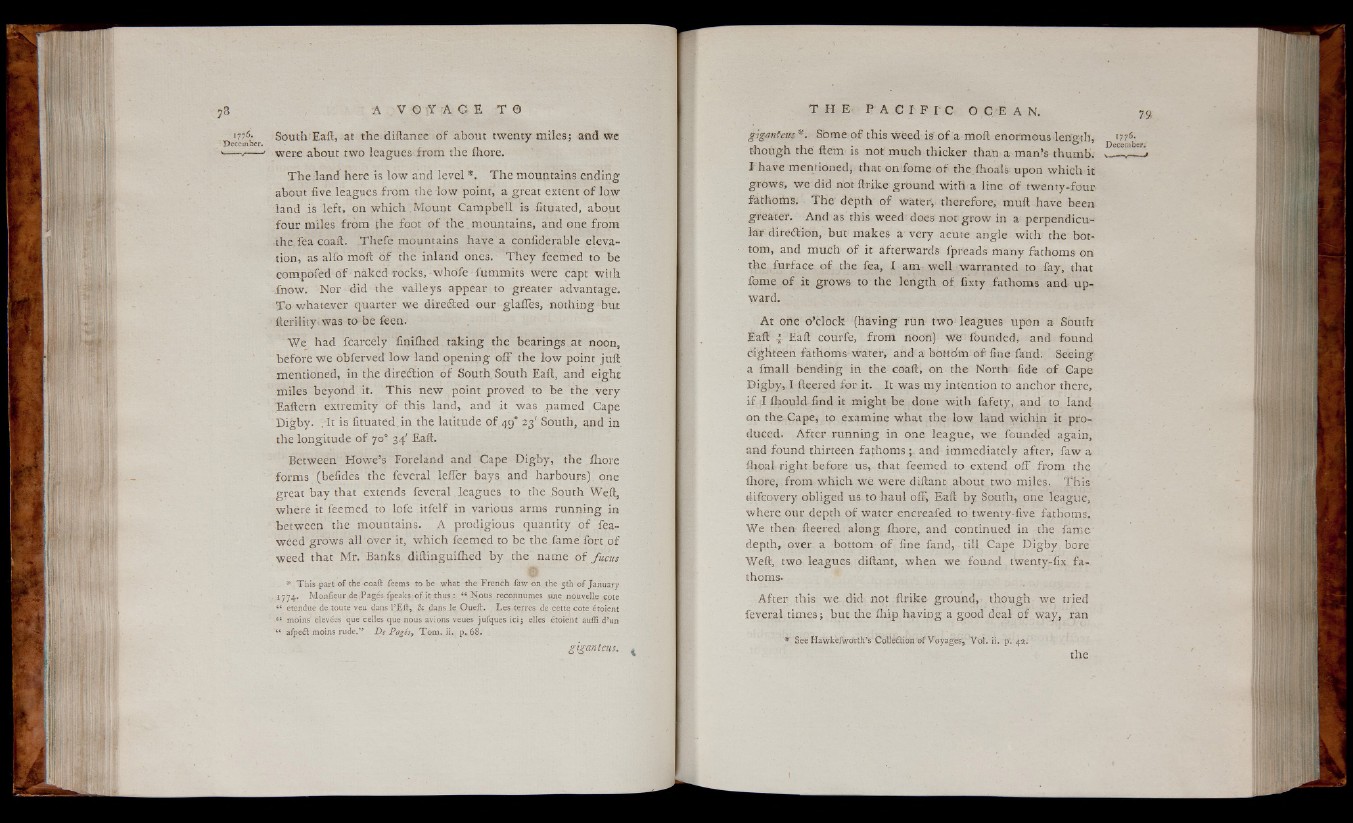
A , V G Y A C E T 0
South Eaft, at the diftance of about twenty miles; and we
were about two leagues from the ihore.
The land here is low and level *. The mountains ending
about five leagues from the low point, a great extent of low
land is left, on which Mount Campbell is fituated, about
four miles from the foot of th e . mountains, and one from
the fea caaft. Thefe mountains have a confiderable elevation,
as alfo moft o f the inland ones. They feemed to be
compofed of naked rocks, whofe fummits were capt with
fnow. Nor did the valleys appear to greater advantage.
To whatever quarter we directed our glafies, nothing but
fterilkytwas to be feen.
"We had fcarcely finiihed taking the bearings at noon,
before we obferved low land opening off the low point juft
mentioned, in the direction of South. South Eafl, and eight
miles beyond it. This new point proved to be the very
Eaftern extremity of this land, and it was named Cape
Digby. . It is fituated in the latitude of 49° 23' South, and in
the longitude of 70° 34' Eaft.
Between Howe’s Foreland and Cape Digby, the ihore
forms (befides the feveral leffer bays and harbours) one
great bay that extends feveral leagues to the South Weft,
where it feemed to lofe itfelf in various arms running in
between the mountains. A prodigious quantity of fea-
weed grows all over it, which feemed to be the fame fort of
weed that Mr. Banks diftinguiftied by the name of fucus
* This part of the coaft feems to be what the French law on the 5th of January
1774. Moniieur;de.Pages (peaks-of it, thus : 46 N.oUs reconnumes une nouvelle ,ppte
44 etendue de toute veu dans PJEft, & dans le Oueft. Les terres de cette cote etoient
44 moins elevees que celles que nous avions veues jufques icij elles etoient aufli d’un
44 afpedt moins rude.” De Pages, Tom. ii.; p.. 68.
giganteus. *
T H E P A C f F r C O C E A N. %%
giganteus*. Some o f this Weed is o f a moft enormous length, *77®-
though the ftem is not much thicker than a man’s thumb.
I have mentioned; that on fome of the fhoals upon which it
grows, we did not ftrike ground with a line o f twenty-four
fathoms. The depth of water, therefore, muft have been
greater. And as this weed'does not grow in a perpendicular
direction, but makes a very acute angle with the bottom,
and much of it afterwards fpreads many fathoms on
the furface of the fea, I am well warranted to fay, that
fome of it grows to the length of fixty fathoms and upward.
At one o’clock (having run two- leagues upon a South
Eaft 4- Eaft courfe, from noon) we founded, and found
eighteen fathoms water, and a bottom o f fine land. Seeing
a fmall bending in the coaft, on the North fide of Cape
Digby, I fleered for it. It was my intention to anchor there,
if I fhould find it might be done with fafety, and to land
on the Cape, to examine What the low land within it produced.
After running in one league, we founded again,
and found thirteen fathoms ; and immediately after, faw a
flioal right before us, that feemed to extend off from the
ihore, from which wè were diftant about two miles. This
difeovery obliged us to haul off, Eaft by South, one league,
where our depth of water encreafed to twenty-five fathoms.
We then fleered along ihore, and continued in the fame'
depth, over a bottom of fine fand, till Cape Digby bore
Weft, two leagues diftant, when we found twenty-fix fathoms.
After this we did not ftrike ground, though we tried
feveral times; but the fhip having a good deal of way, ran
* See HawkefwCrth’s CollëÉlioii of Voyages’, Vol. ii. p. 42►
the